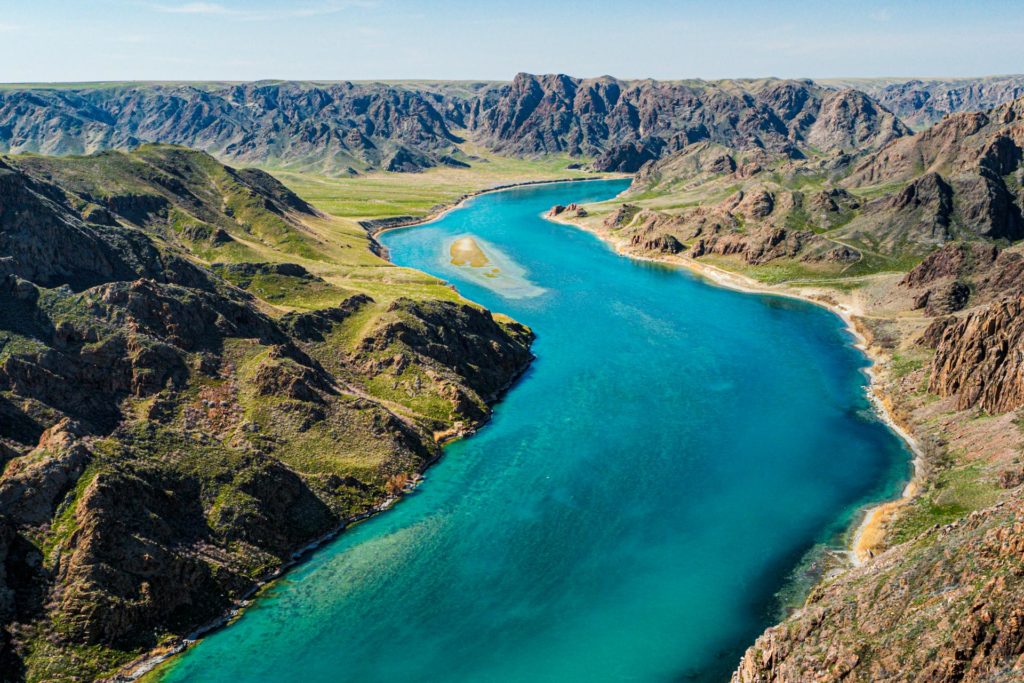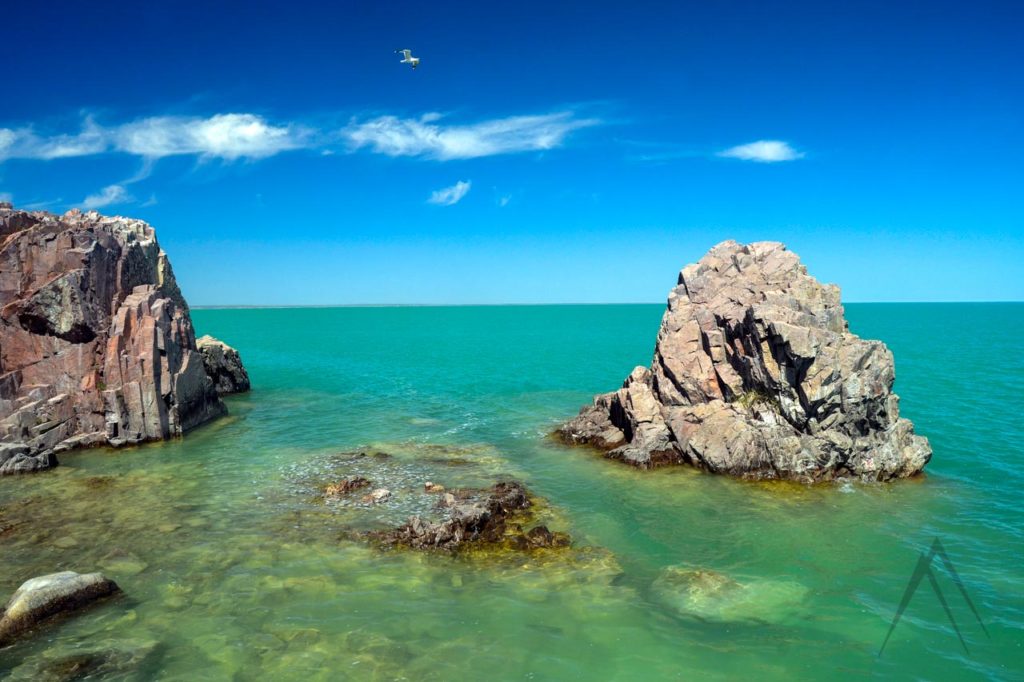Balkhash Lake
Lake Balkhash
Balkhash Lake is an endorheic basin lake, located in the South-Eastern part of Kazakhstan and is the second-largest lake in Central Asia by area (Northern Aral Sea is larger) and the 13th largest continental lake in the World and has the shape of a huge crescent. The lake width varies from just 5 km to around 70 km and it is 605 km long from west to the east. The water of the lake is greenish and interesting as it is saline in its deeper eastern section, but freshwater in the more shallow western end of the lake. The main inflow into the lake is from the Ili River bringing freshwater to Balkhash. The lake has no outflow and it is usually frozen from November to March due to the cold winters of Kazakhstan. Lake Balkhash is the largest body of water without an exit after the Caspian and Aral seas.
Environmentalists worry that Lake Balkhash is at risk from the similar processes of desiccation to those that have damaged the Aral Sea. The development of the Kapchagai Dam in the 1960s and associated with the development of irrigation agriculture, have decreased the inflow into the lake from the Ili river.
There are also concerns that industrial and agricultural growth in China Xinjiang Region where the headwaters of the Ili lie, will result in enhanced reduction of the inflow or that the pollution to the lake would continue to increase.
The lake nevertheless has many beautiful faces from the sandy or rocky desert beaches to the lush green river delta areas. Mostly Balkhash beaches are in the empty steppe making it a heaven for wildlife.

Inflowing rivers to Balkhash
The Ile River running in from the south towards Balkhash, spills into the western side of the lake and it provided about 80–90 percent of the total water into the lake till a hydroelectric project decreased the amount of the river’s inflow late in the 20th century. Small rivers as the Qaratal, Aqsū, Ayaguz and Lepsi serve the eastern part of the lake.
With almost identical areas in both sections of the lake, this condition creates a constant stream of water from the western to the eastern section. The water of the western section is almost fresh and suitable for industrial use and consumption, and the eastern part is salty due to the mineral rich water of the inflowing rivers and the evaporation being the only route for the water to leave the lake.

Balkhash Legend
As is usual in Central Asia, there should always be a legend. Balkhash is no exception and there is a legend saying that a rich man named Balkhash had a beautiful daughter Ili. Once Balkhash held a feast and promised to give his daughter as a wife for the winner of a contest. But Ili had already fallen in love with the shepherd Karatal and therefore helped Karatal to win the contest of grooms. Balkhash didn’t want to give Ili to a mere shepherd and the young lovers ran away. The angry father could not catch the escapees so he turned them into rivers and turned himself into a lake between them.
What to do in lake balkhash and Balkhash town
From Balkhahs town, you can ride a boat on the lake, go surfing or spearfishing. Balkhash is considered as a warm lake, the water temperature in the summer rises up to 28 °C. Locals and tourists alike swim there from May to September. In summer, fishermen arrive in Balkhash to fish the more than 20 species of fish living in the lake, like Marinka, pike perch, bream and catfish.
There are several fishing bases for fishermen on the coasts, where you also can stay in guesthouses. In the autumn, the hunting season begins on Balkhash to hunt wild boars, hares and ducks. You can also hunt with falcons or eagles for heath-cock, duck, partridge, pigeon, hare, fox and even wolf.
The town center of Balkhash town has wide-open streets where taxis occupy a lot of the space. The main streets are clean and you can walk along Lenin street. There is some interesting architecture from the 1940s and 50s and mosaics that have slowly started to disappear in the modernization drive of the city. There is also House of Culture of Metalworkers in the Lenin crosses Valikhanov street as well as a small history museum chronicling the story of the copper plant of Balkhash as it is an industrial town focused in the processing of copper ore.
As a summary, Balkhash lake area is most appealing to the nature lovers and especially bird watchers.


Around Balkhash
Vast Balkhash lake is located on the territory of three regions of Kazakhstan – Almaty, Karaganda and Zhambyl. It is surrounded by Paleozoic folding structures: Saryarka small hills, Tarbagatai, Zhungarsky Alatau and Chu-Ili. The north shores of the lake are high and rocky, with obvious tracks of ancient landscapes. The south banks are flat and sandy and broad areas of them are covered with thickets plants and numerous small lakes. These low-lying edges are periodically flooded by the waters of the lake. The largest settlement of the shore of the lake is the town of Balkhash situated on the north shore in the Karaganda region.


Bektau Ata Mountain Range
Bektau Ata is a unique natural environment that differs from the stepped surroundings in this area. It is a group of granite hills, the largest one reaching up to 1232 m in height and is therefore well visible from the otherwise very flat area. This mysterious are is located 60 kilometers north of the city of Balkhash. Geologists call this place pluton – a volcano that did not have time to erupt.
The rocky hill covers an area of about 4000 ha with a radius of about 6 km. It splits into several massifs: Bektauata, Sarykulzha (Yellow argali), Konyrkulzha (Brown argali) – with the Apar Su pass between them, Karashoky, Zhaltas. The mountains are attracting with their amazing volcanic forms and are surrounded by poplar and juniper groves. During rainy periods and after winter, whole cascades of small lakes are formed on the slopes. Here you can find cranes as well as sandpipers, rare argali and gazelles.
The geological history of Bektau Ata is a real volcanic thriller. It will be much more interesting to find out that Bektau Ata is only a part of the Balkhash-Ili volcanic belt, which also includes the Ketmen ridge, the northern spurs of the Zailiysky Alatau, the southern spurs of the Altyn-Emel and Dzhungarsky Alatau ranges, as well as the Karkaraly mountains and the coast of Lake Alakol. This region began to form in the Carboniferous (350 million years ago) when the hard earth’s crust was split from the inside by a powerful ascending granite layer. Hot magma entered the surface through deep faults, and at the beginning of the Permian period (295 million years ago) began to erupt, forming volcanic plateaus with large annular depressions on the surface.
Over the course of 16 million years, incandescent melts rose from the depths of the earth, which formed cone and shield-like pale volcanoes on the surface. However, even after the cessation of eruptions (250 million years ago), “intrusive” granite masses continued their way upward, melting and lifting the frozen outer layers. Over time, the fragments of the squeezed out surface layer were washed away, and the granite mountains Bekatu Ata, Bayanaul and Karkaraly appeared to the world.


How to get to lake balkhash
Plane
Balkhahs can be reached by plane through the airport that is located 6 km northwest from the Balkhash. ZhezAir operates regular flights to Almaty on an Antonov-40 plane. The only option to get to/from this airport is take take taxi to/from the Balkhash town.
Train
There is a railway station at the northwest edge of the town, off Zhezkazgan street. For the departure and arrival schedules you can check in the official website:
By car
If you are traveling around Kazakhstan by a car, traveling to Balkhash may open you to the actual Kazakh distances and low population density. The main highway north from Almaty to Astana stretches for about 400 km via mostly desolate steppe between Balkhash and Karaganda. From Astana via Karaganda, the road to Balkhash is approximately 600 km and takes about 9 hours.
The distance from Almaty to the city of Balkhash is about 640 km making it about 9,5 hours of journey. You can also get to the village of Lepsy in 8 hours, which is 420 km from Almaty. Since Balkhash is located in the middle of Almaty and Astana, it is a perfect place to overnight.